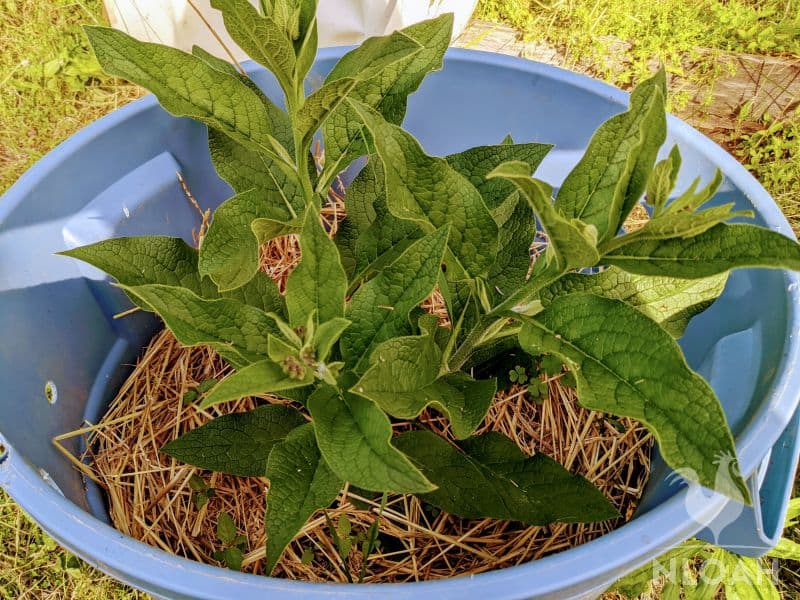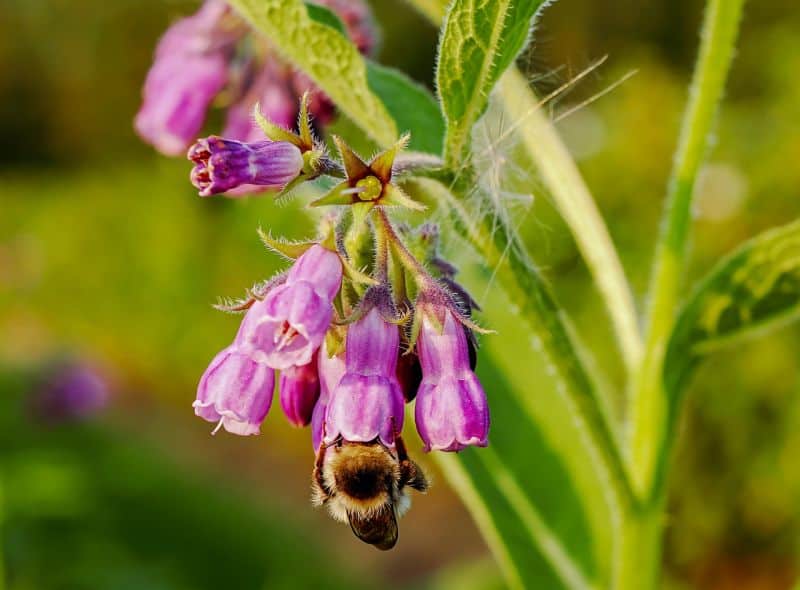Comfrey is a beautiful and medicinal herb. You can easily grow this shrub style herb plant in either ground plots or containers.
Comfrey can be cultivated in an apothecary patch on the homestead, or used as part of an edible landscaping project in traditional landscaping flower beds.

This healing herb typically grows to reach heights of five feet tall. Comfrey generates clusters of flowers that come in various shades of blue, purple, and white. This herb plant has slender and long leaves, and is known for its unusual black skinner roots.
It is the roots of the comfrey plant that have most prominently been used in healing natural remedies for centuries. In Japan especially, comfrey was dubbed “knitbone.” The herb is known for its analgesic, anti-inflammatory, and astringent properties.
Table of Contents:
Comfrey Hardiness Zones
Comfrey is a perennial plant that is hardy in USDA Growing Zones 3 through 9. An established or mature comfrey plant may be able to sustain a light frost, but not a hard one once it leaves its dormant winter state.
Comfrey plants are cut back before winter, and they do not begin actively growing again until the spring. Never place germinating seeds, cuttings, or young plants outdoors before the final threat of a frost has passed in your respective growing zones.
10 Most Common Types of Comfrey Plants
There are at least 35 different types of comfrey plants. The most commonly planted variety is Bocking 14 – or Russian comfrey. This version of the plant is a hybrid of rough comfrey and common comfrey plants.
- Common Comfrey
- Russian Comfrey
- Rough Comfrey
- Prickly Comfrey
- White Comfrey
- Crimean Comfrey
- Bulbous Comfrey
- Creeping Comfrey
- Tuberous Comfrey
- Caucasian Comfrey
Can Livestock Eat Comfrey?
Poultry birds, cattle, hogs,goats, rabbits, and sheep can eat comfrey fresh or after it has been dried into a hay type material.
Allowing comfrey to dry in the sun or inside of a dehydrator will preserve it in a hay-like state so it can easily be fed to livestock during the winter months.
The Benefits of Growing Comfrey in the Garden
This herbal plant benefits a conventional or permaculture garden by attracting pollinators and beneficial insects. Bringing more of these helpful little creatures into the garden area will help you all of your plants grow to produce a robust yield and keep the infestations of destructive insects low.
- Honey Bees
- Bumble Bees
- Butterflies
- Ladybugs
- Green Lacewings
- Aphid Parasites
- Fungus Gnat Predators
- Mealybug Destroyers
- Soldier Bugs
- Spider Mite Protectors
Comfrey as a Liquid Feed or Mulch
Because comfrey has a wonderful balance of potassium, phosphorus, and nitrogen, it is often used in many natural liquid plant food recipes and as mulch.
To use comfrey as mulch, simply cut up stem and leaf parts, and scatter them around other plants in the garden.
The comfrey plant parts will begin to rot quickly, allowing their nutrients to seep into soil around the plant it is mulching. The potassium content in comfrey is especially useful around any type of fruiting plant – tomatoes in particular.
A comfrey mulch also helps conserve moisture in the soil, and can help reduce the need to water plants during times of low rainfall. The large comfrey leaves may help deter weeds from growing up around plants during the mulching process, as well.
The comfrey mulch is extremely beneficial is you are practicing a “no dig” style of gardening and seek to disturb the soil ecosystem as little as feasible while tending to the weeds growing up around your crops.
Comfrey Tea as Plant Food
A “comfrey tea” is simple to make and is a superb liquid plant food. All of the comfrey plant parts growing above ground can be chopped up and brewed to make the tea. Use a one part plant parts to two parts water ratio when making the comfrey compost liquid tea.
Comfrey Tea Recipe for Your Plants
Instructions
- Place the leaves and other above ground plant parts in a bucket that has a lid or another large container that can be similarly sealed.
- Pour hot to boiling water into the container, making sure that all of the plant parts are covered.
- Place a brick or similarly heavy item onto the plant parts to keep them from floating to the surface of the water.
- Place the lid on the container and allow the mixture to steep and “rot down” for about six weeks.
- Strain away any debris left in the water and use the comfrey tea to pour or squirt around plants in the garden.
- Place the leaves and other above ground plant parts in a bucket that has a lid or another large container that can be similarly sealed.
- Pour hot to boiling water into the container, making sure that all of the plant parts are covered.
- Place a brick or similarly heavy item onto the plant parts to keep them from floating to the surface of the water.
- Place the lid on the container and allow the mixture to steep and “rot down” for about six weeks.
- Strain away any debris left in the water and use the comfrey tea to pour or squirt around plants in the garden.

How to Grow Comfrey
This herb plant does best in a well draining soil. This hardy herb plant goes dormant in the winter, but will emerge again in the springtime.
- Start seeds indoors in early March so they can be transplanted outside as soon as the threat of a hard frost has passed.
- If planting outdoors, wait until the last threat of a hard frost has passed in your growing zone.
- Seeds should be planted one fourth of an inch deep, and watered lightly after sowing.
- Plant comfrey in partial shade.
- Plant each comfrey plant at least one foot away from another, or from any other plant growing in the same bed. Comfrey grows in a bush shape, and will often try to take over any space where it is planted – often crowding neighboring plants. Comfrey often grows to between two to four feet in diameter.
- If growing comfrey in a container, it will need to boast a wide diameter opening and be at least five gallon in size.
- Recommended companion plants for comfrey include: nectarine, apple, plum, apricot, pear, and peaches.
Comfrey Growing Tips
- Cutting the large comfrey plants back at the end of summer will help spark new growth, and more beautiful and foliage.
- The greens that are cut back from the comfrey plant make an excellent addition to the compost pile.
- Spread a manure based mulch over the cut back plants before winter begins to help give the comfrey plants a healthy start for the spring growing season.
- To bolster growth throughout the spring and summer, consider spreading poultry bird droppings around comfrey plants.
- If the soil becomes too acidic and the plant starts to show signs of distress like drooping or discolored leaves, spread agricultural lime around the base to help replenish the soil.
- Infusing a little bit of nitrogen into the soil (about three ounces per mature plant) can help bolster growth on a dwindling or stunted plant.
- Comfrey will thrive in soil with a 6 to 7 pH balance.
Growing Comfrey from Seeds
- When comfrey is grown from seed, it is easier to start from cuttings.Growing this herbal plant from seed requires a period of chilling during the winter in order to germinate properly. It can take up to two years for comfrey seed to germinate.
- To cultivate comfrey from root cuttings, make sure the starts are between two to six inches in length and are planted between 2 to 6 inches deep horizontally in the soil. Comfrey is not picky about soil, but clay soil seems to work best with cuttings. Soak the cuttings in Lukewarm water for about an hour before planting for best results.
- A comfrey crown cutting often grows more quickly than root cuttings. Make sure that any piece of crown you cut to plant includes at least two eyes, for best results. Plant crown cuttings three to six inches deep and space them three feet apart.
- Space rows of plants one foot and 11 inches to two feet apart with the same spacing being used for row gaps.
Comfrey Placement Selection
This multi-purpose herb plant will regrow again and again from even the smallest of root fragments – a single comfrey plant can last for about a decade – or longer. Choose the garden planting spot carefully with long range plans in mind.
Comfrey is known to be able to withstand both shade and wet growing conditions quite well. This means the herb plants can thrive in spots not really suitable for a large variety of other herb, medicinal flower, or garden crop plants.
Placing comfrey plants in an orchard, forest permaculture garden or, or guild growing set up alongside perennials and annuals can help them grow due to its natural pollinator attracting abilities – as long as it is planted with enough space to grow without causing crowding or casting too much shade on other plants.
Comfrey Pests
Comfrey is hardy against nearly all common garden pests – even leaf miners and aphids. But, if you are experiencing a Japanese beetle problem, expect them to converge on your comfrey plants, as well.
Yellow jackets are the only Japanese beetle predator that exists in the United States. The best way to get rid of Japanese beetles is to turn the soil during the winter months to expose larvae and stop an infestation before it starts.
Sprinkling diatomaceous Earth or a three to one mixture of flour and standard table salt around the base of the plant and onto the plant itself during the early morning hours (to avoid scorching) can prove successful when battling those darn destructive beetles.
Either the DE or the flour and salt mixture dehydrated insects that get it stuck to their body or consume it – both bad bugs and beneficial ones will experience the same fate.
Comfrey Diseases
Comfrey rust is a fungal disease that can take care of an entire plant quickly. It is the only real plant disease threat this hardy herb generally faces.
When rust develops, you will notice tiny orange spots appearing on the underside of the leaves. The spots will spread and ultimately results in spore development that often spreads to other plants.
Be vigilant about the development of rust spots, especially during periods of excessive rain. When caught early and the infected leaves are cut down to ground level, the plant may come back to robust health.
Always thoroughly disinfect any gardening tools and gloves that come into contact with rust fungus before using them on other plants or storing them away.
How to Harvest Comfrey
- The roots of the comfrey plants can be harvested for use any time of the year, but are typically deemed best for use during the winter months.
- The gathering of greens is best done in the early weeks of summer and can occur again at the beginning of fall.
- Comfrey plants boast small and prickly leaves, somewhat akin to stinging nettles. It is best to wear work gloves when cutting back the plant before winter or when harvesting greens.
Comfrey Healing Uses and Cautions
- Minor Burns
- Bruises
- Gout
- Arthritis
- Muscle Sprains
- Joint Inflammation
Extracts that are made from comfrey leaves and roots are often used as base ingredients in natural homemade salves, ointments, and creams.
As with any plant that is used in DIY healing remedies, you should not use it without first consulting a physician because allergic reactions, negative reactions with other medications (natural or manufactured) could result.
This herb was once used as a natural remedy for stomach aches and diarrhea, but is no longer advised for internal health issues.
While selling oral products that contain comfrey is legal in some countries, others have banned such items for fear that it could potentially harm the liver or might be carcinogenic when ingested or used on open wounds.
The use of comfrey on the skin even when no open wounds are involved might not be advisable for pregnant and breastfeeding women, the elderly, and young children or babies. It is not recommended to use comfrey longer than 10 days at a time on unbroken skin, or for more than four to six total weeks during a single calendar year.
If making natural healing salves and/or growing your own chicken and other livestock feed is part of your homesteading plan, cultivating comfrey may help you achieve those goals. This is a hardy and versatile herb when grown and used as recommended.


Tara lives on a 56 acres farm in the Appalachian Mountains, where she faces homesteading and farming challenges every single day, raising chickens, goats, horses, and tons of vegetables. She’s an expert in all sorts of homesteading skills such as hide tanning, doll making, tree tapping, and many more.
